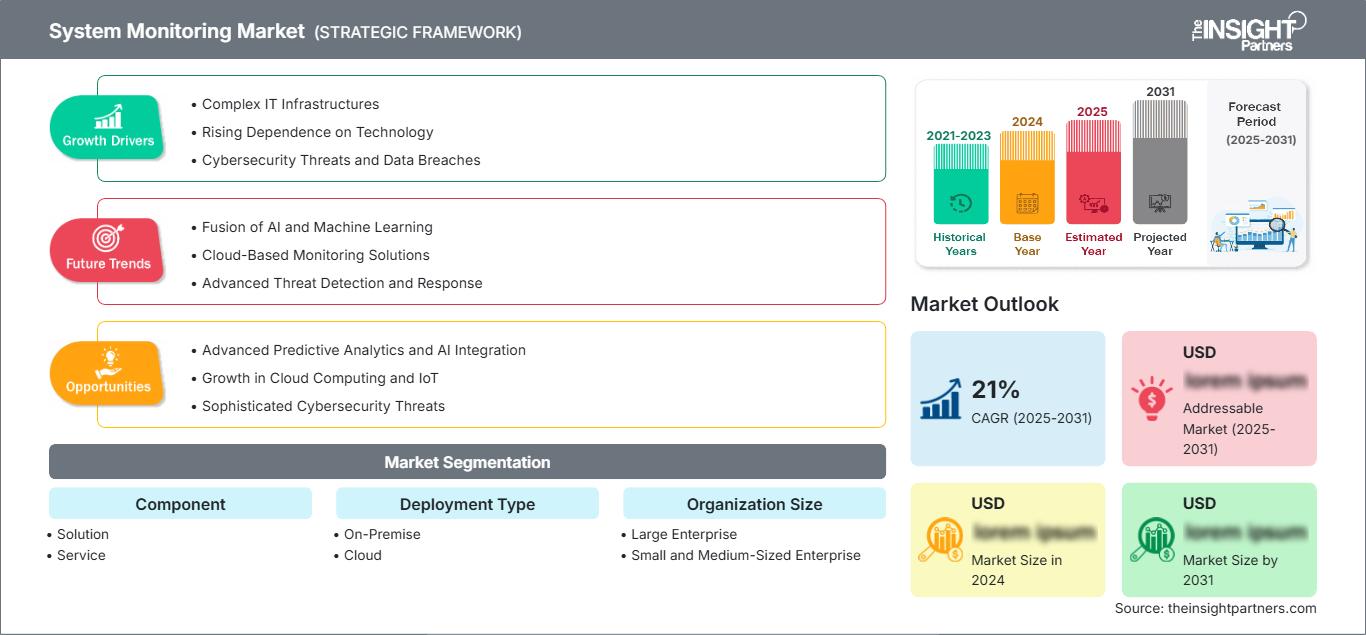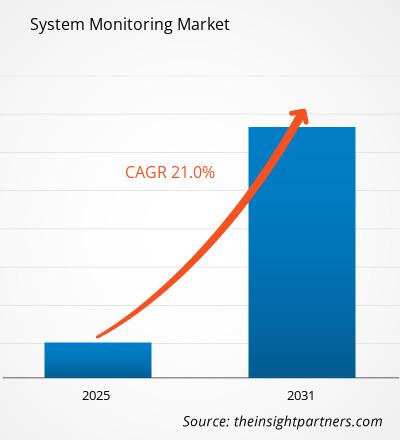Si prevede che il mercato del monitoraggio dei sistemi registrerà un CAGR del 21% dal 2025 al 2031, con una dimensione del mercato in espansione da XX milioni di dollari nel 2024 a XX milioni di dollari entro il 2031.
Il rapporto di ricerca di mercato sul monitoraggio dei sistemi è suddiviso per componente nei seguenti sottosegmenti: soluzione e servizio. Il rapporto fornisce inoltre un'analisi basata sul tipo di implementazione, ovvero on-premise e cloud, per dimensione dell'organizzazione, ovvero PMI e grandi imprese, nonché per settore verticale, ovvero BFSI, IT e telecomunicazioni, pubblica amministrazione, energia e servizi di pubblica utilità, sanità e produzione. L'analisi è inoltre suddivisa per settore verticale, ovvero BFSI, IT e telecomunicazioni, pubblica amministrazione, energia e servizi di pubblica utilità, sanità e produzione. L'analisi globale è suddivisa a livello regionale e per i principali paesi. La valutazione del mercato è presentata in dollari USA per l'analisi segmentale di cui sopra.
Scopo del rapporto
Il rapporto "System Monitoring Market" di The Insight Partners mira a descrivere il panorama attuale e la crescita futura, i principali fattori trainanti, le sfide e le opportunità. Ciò fornirà spunti a vari stakeholder aziendali, come:
- Fornitori/Produttori di tecnologia: per comprendere le dinamiche di mercato in evoluzione e conoscere le potenziali opportunità di crescita, consentendo loro di prendere decisioni strategiche informate.
- Investitori: per condurre un'analisi completa delle tendenze in merito al tasso di crescita del mercato, alle proiezioni finanziarie di mercato e alle opportunità esistenti lungo la catena del valore.
- Enti di regolamentazione: per regolamentare le politiche e le attività di controllo sul mercato con l'obiettivo di ridurre al minimo gli abusi, preservare la fiducia degli investitori e sostenere l'integrità e la stabilità del mercato.
Componente di segmentazione del mercato del monitoraggio del sistema
- Soluzione
- Servizio
Tipo di distribuzione
- On-premise
- Cloud
Dimensione dell'organizzazione
- Grande impresa
- Piccola e media impresa
Verticale
- BFSI
- IT e telecomunicazioni
- Governo
- Energia e servizi di pubblica utilità
- Sanità
- Produzione
Potrai personalizzare gratuitamente qualsiasi rapporto, comprese parti di questo rapporto, o analisi a livello di paese, pacchetto dati Excel, oltre a usufruire di grandi offerte e sconti per start-up e università
Mercato del monitoraggio del sistema: Approfondimenti strategici

- Ottieni le principali tendenze chiave del mercato di questo rapporto.Questo campione GRATUITO includerà l'analisi dei dati, che vanno dalle tendenze di mercato alle stime e alle previsioni.
Fattori di crescita del mercato del monitoraggio dei sistemi
- Infrastrutture IT complesse: la crescente complessità delle infrastrutture IT sta determinando la domanda di soluzioni di monitoraggio dei sistemi robuste per garantire prestazioni e tempi di attività ottimali.
- Crescente dipendenza dalla tecnologia: poiché le industrie fanno sempre più affidamento sulla tecnologia, la necessità di sistemi di monitoraggio efficaci diventa essenziale.
- Minacce alla sicurezza informatica e violazioni dei dati: l'aumento delle minacce alla sicurezza informatica e delle violazioni dei dati sottolinea l'importanza del monitoraggio dei sistemi in tempo reale per identificare e affrontare le vulnerabilità della sicurezza.
- Sfide del cloud computing e della virtualizzazione: l'uso delle tecnologie di cloud computing e virtualizzazione aumenta la necessità di strumenti di monitoraggio avanzati per gestire le nuove sfide.
Tendenze future del mercato del monitoraggio dei sistemi
- Fusione di intelligenza artificiale e apprendimento automatico: l'integrazione dell'intelligenza artificiale con l'apprendimento automatico migliorerà l'analisi, automatizzerà le risposte agli incidenti e ottimizzerà i dispositivi IoT e edge computing.
- Basato su cloud Soluzioni di monitoraggio: le soluzioni basate su cloud offriranno maggiore scalabilità, flessibilità e convenienza nel monitoraggio del sistema.
- Rilevamento e risposta avanzati alle minacce: con l'aumento della sofisticatezza delle minacce informatiche, aumenterà la necessità di meccanismi avanzati di rilevamento e risposta alle minacce.
- Impatto della tecnologia 5G: con l'avvento del 5G, le applicazioni si espanderanno rapidamente, creando una domanda sostanziale di funzionalità avanzate di monitoraggio e ottimizzazione in tempo reale.
Opportunità di mercato per il monitoraggio del sistema
- Analisi predittiva avanzata e integrazione dell'intelligenza artificiale: l'uso dell'apprendimento automatico e dell'intelligenza artificiale negli strumenti di monitoraggio sbloccherà un potenziale significativo per l'analisi predittiva e la risposta agli incidenti in tempo reale.
- Crescita del cloud computing e dell'IoT: l'espansione del cloud computing e dei dispositivi IoT creerà nuove opportunità per le soluzioni di monitoraggio per gestire e proteggere queste tecnologie.
- Minacce sofisticate alla sicurezza informatica: con l'aumento della sofisticatezza delle minacce informatiche, aumenterà la domanda di funzionalità avanzate di rilevamento e risposta alle minacce nel monitoraggio soluzioni.
- Protezione dei dati e conformità normativa: la crescente necessità di protezione dei dati e di conformità ai requisiti normativi determinerà la richiesta di soluzioni di monitoraggio complete, studiate su misura per proteggere le informazioni sensibili e soddisfare le normative specifiche del settore.
Mercato del monitoraggio dei sistemi
Le tendenze regionali e i fattori che influenzano il mercato del monitoraggio dei sistemi durante il periodo di previsione sono stati ampiamente spiegati dagli analisti di The Insight Partners. Questa sezione illustra anche i segmenti e la geografia del mercato del monitoraggio dei sistemi in Nord America, Europa, Asia-Pacifico, Medio Oriente e Africa, America Meridionale e Centrale.
Ambito del rapporto di mercato sul monitoraggio del sistema
| Attributo del rapporto | Dettagli |
|---|---|
| Dimensioni del mercato in 2024 | US$ XX million |
| Dimensioni del mercato per 2031 | US$ XX Million |
| CAGR globale (2025 - 2031) | 21% |
| Dati storici | 2021-2023 |
| Periodo di previsione | 2025-2031 |
| Segmenti coperti |
By Componente
|
| Regioni e paesi coperti | Nord America
|
| Leader di mercato e profili aziendali chiave |
|
Densità degli operatori del mercato del monitoraggio del sistema: comprendere il suo impatto sulle dinamiche aziendali
Il mercato del monitoraggio di sistema è in rapida crescita, trainato dalla crescente domanda degli utenti finali, dovuta a fattori quali l'evoluzione delle preferenze dei consumatori, i progressi tecnologici e una maggiore consapevolezza dei vantaggi del prodotto. Con l'aumento della domanda, le aziende stanno ampliando la propria offerta, innovando per soddisfare le esigenze dei consumatori e sfruttando le tendenze emergenti, alimentando ulteriormente la crescita del mercato.

- Ottieni il Mercato del monitoraggio del sistema Panoramica dei principali attori chiave
Punti di forza
- Copertura completa: il rapporto analizza in modo esaustivo prodotti, servizi, tipologie e utenti finali del mercato del monitoraggio di sistema, offrendo una panoramica olistica.
- Analisi degli esperti: il rapporto è redatto sulla base della conoscenza approfondita di esperti e analisti del settore.
- Informazioni aggiornate: il rapporto garantisce la pertinenza aziendale grazie alla copertura di informazioni e tendenze dei dati recenti.
- Opzioni di personalizzazione: questo rapporto può essere personalizzato per soddisfare le esigenze specifiche del cliente e adattarsi in modo appropriato alle strategie aziendali.
Il rapporto di ricerca sul mercato del monitoraggio di sistema può quindi contribuire a guidare il percorso di decodificazione e comprensione dello scenario del settore e delle prospettive di crescita. Sebbene possano esserci alcune valide preoccupazioni, i vantaggi complessivi di questo rapporto tendono a superare gli svantaggi.
- Analisi storica (2 anni), anno base, previsione (7 anni) con CAGR
- Analisi PEST e SWOT
- Valore/volume delle dimensioni del mercato - Globale, Regionale, Nazionale
- Industria e panorama competitivo
- Set di dati Excel
Report recenti
Testimonianze
Motivo dell'acquisto
- Processo decisionale informato
- Comprensione delle dinamiche di mercato
- Analisi competitiva
- Analisi dei clienti
- Previsioni di mercato
- Mitigazione del rischio
- Pianificazione strategica
- Giustificazione degli investimenti
- Identificazione dei mercati emergenti
- Miglioramento delle strategie di marketing
- Aumento dell'efficienza operativa
- Allineamento alle tendenze normative




















 Ottieni un campione gratuito per - Mercato del monitoraggio del sistema
Ottieni un campione gratuito per - Mercato del monitoraggio del sistema